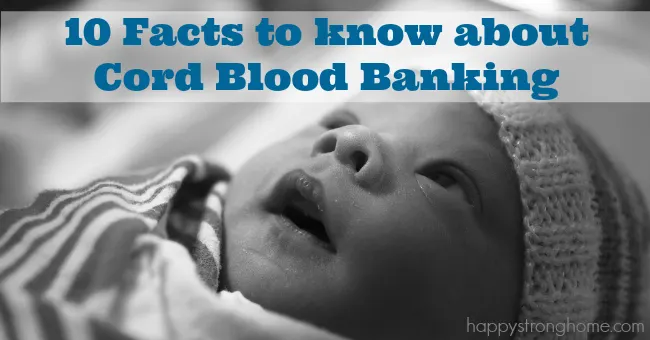If you’re getting ready to have a baby, or even trying to conceive, there’s so much information that is going to come at you in the next months and years! You’ll have to make a lot of important, one-time decisions as you progress through pregnancy and delivery. Naming the baby is the easy part!
Decisions about genetic testing, breastfeeding, vaccinations, natural birth methods, and even more may leave you feeling confused and a little shell shocked. So today, I’m going to give you some important information to help you with another big decision: cord blood banking.
Cord blood banking is something I definitely heard and read a little bit about before my children were born, but really didn’t feel I knew enough to make an informed decision, so we declined. Blessedly, our children are healthy and thriving. Still, since cord blood can be used to treat conditions up to decades later, I wish we’d put more thought into budgeting for cord blood banking with our children.

Here’s 10 facts to know about cord blood banking
1. Cord blood banking comes from your child’s own umbilical cord. The umbilical cord stem cells, which are immature, undifferentiated cells, get preserved and stored for later use.
2. Umbilical cord stem cells can be used to replace damaged or diseased cells. In the event of a catastrophic illness in your child’s lifetime, these cells can become an invaluable treatment option.
3. Stem cells can be preserved for years, even decades. StemCyte, a leading cord blood bank, uses a proprietary stem cell optimization process to recover 99% (or higher) of viable stem cells, the highest number of functional, usable cells recovered in the industry.
4. Cord blood banking poses no risk to the mother or baby. The umbilical stem cells are collected from what would be simply discarded as medical waste if not banked.
5. Umbilical cord stem cells are a 100% match to the child. This is so helpful when treating serious conditions. The cord blood may also be a match or partial match for a sibling.
6. Cord blood banking is as easy as bringing a kit to the hospital with you. Trained hospital staff collect the blood and ship it out to the cord blood bank, using real time tracking and averaging 19 hours delivery time from hospital to lab!
7. Cord blood has been used in over 80 diseases and disorders. For over 20 years, doctors have used cord blood to treat conditions from blood disorders, cancers, immune disorders and more!
8. You can do delayed cord clamping along with cord blood collection.
9. Put Cord Blood Banking on your baby shower registry! Yes, you can invite friends and family to contribute to the cost of banking your newborn’s cord blood.
10. It costs less than you think. Long term, that is over your child’s first 18 years, the cost averages out to less than $200 a year. Banking plans and pricing plans do vary, depending on what you choose to bank (cord blood only, or also cord tissue). Compared to the medical costs of a long-term or terminal illness, that is nothing!
There you have it, 10 facts to know about cord blood banking.
I hope it was helpful for you as you begin (or continue) the exciting adventure of growing your family!
What questions do you still have about cord blood banking? Most of my information I found on the MayoClinic site and the Cord Blood Registry site, where you’ll find many more details!
To learn more about cord blood banking or free cord blood donation (also an option!), please click here to indicate your interest!
Did you use cord blood banking for your children? Do you plan to? Tell me about your experiences!

This is a partnered post with Data Rank and StemCyte. All opinions are my own.

